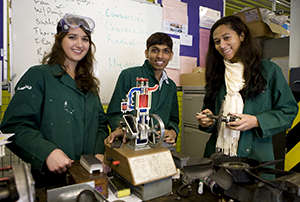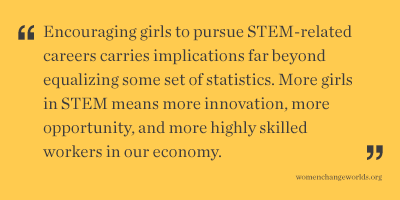
Females outnumber their male colleagues in higher education, tend to get better grades, yet do not proportionately pursue STEM-related (science, technology, engineering, and math) fields. A woman’s participation or pursuit of STEM-related studies is a question of choice, not ability. Women are just as intellectually and academically capable of performing in STEM fields, yet the share of STEM bachelor’s degrees awarded to women over the past decade has fallen. Unfortunately, statistics about the participation (or lack thereof) of women in STEM fields should not come as a surprise; for far too long headlines have told this all too familiar story. Though we have long been aware of these alarming statistics, we should set forth to understand it and find ways to combat it.
There is no shortage of literature on this topic. A simple search of the phrase “girls in STEM” yields a staggering number of results. Though it goes without saying that solutions to closing the participation gap are heavily rooted within the plethora of reports regarding the achievement gap, longitudinal studies on children’s beliefs about academic competency, and sex-linked interest preferences, that focus on the strategies in which we can encourage girls to pursue STEM fields will make us most aware of the ways we can reverse the alarming aforementioned statistics.
Keys to Encouraging Girls to Pursue Math and Science
 National nonprofit organizations like Women Who Code have already inspired thousands of young girls to pursue math and science because they created a community of support and mentorship. Change, however, is not solely made by the positive influence of one organization. Change, rather, is the result of continued, localized efforts. Teachers, parents, and peers can provide a reliable network for aspiring female mathematicians. Encouraging girls to pursue STEM-related careers carries implications far beyond equalizing some set of statistics. More girls in STEM means more innovation, more opportunity, and more highly skilled workers in our economy. Most importantly, however, encouraging STEM means that every student has the ability to freely pursue his or her true passion without societal inhibition. As we think about the ending of another school year and opportunities for summer exploration, we must remember to not only endeavor to help girls realize the importance of math, but also to realize their propensity to achieve.
National nonprofit organizations like Women Who Code have already inspired thousands of young girls to pursue math and science because they created a community of support and mentorship. Change, however, is not solely made by the positive influence of one organization. Change, rather, is the result of continued, localized efforts. Teachers, parents, and peers can provide a reliable network for aspiring female mathematicians. Encouraging girls to pursue STEM-related careers carries implications far beyond equalizing some set of statistics. More girls in STEM means more innovation, more opportunity, and more highly skilled workers in our economy. Most importantly, however, encouraging STEM means that every student has the ability to freely pursue his or her true passion without societal inhibition. As we think about the ending of another school year and opportunities for summer exploration, we must remember to not only endeavor to help girls realize the importance of math, but also to realize their propensity to achieve.
Sophia Zupanc is a Wellesley College student (class of 2019) and a Wellesley Centers for Women Student Ambassador.
When you subscribe to the blog, we will send you an e-mail when there are new updates on the site so you wouldn't miss them.
Comments